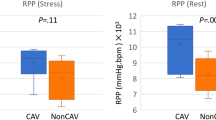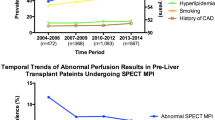Abstract
Objectives
We sought to determine the safety of regadenoson (REG) stress testing in patients who have undergone orthotopic heart transplantation (OHT).
Background
Routine screening for cardiac allograft vasculopathy (CAV) is necessary after OHT. Adenosine stress is contraindicated after heart transplantation due to supersensitivity in denervated hearts. Safety of regadenoson stress following OHT has not been well studied.
Methods
We retrospectively reviewed data from OHT patients (N = 123) who were referred to REG stress testing. Medical records were reviewed to determine hemodynamic and ECG response to regadenoson and to identify adverse reactions.
Results
No serious adverse events occurred. No life-threatening arrhythmias or hemodynamic changes occurred. Common side-effects related to regadenoson were observed, dyspnea being the most frequent (66.7%). On average the heart rate rose from 82.8 ± 12 to 95.7 ± 13.4 bpm (P < 0.001), systolic blood pressure decreased from 138.7 ± 20.9 to 115.9 ± 23.9 mmHg (P < 0.001) and mean arterial pressure decreased from 103.5 ± 14.1 to 84.72 ± 15.90 mmHg (P < 0.001) during stress protocol. There was no sustained ventricular tachycardia, ventricular fibrillation, or second-or third-degree atrioventricular block.
Conclusion
Regadenoson stress testing appears to be well tolerated and safe in OHT patients.
Similar content being viewed by others
Abbreviations
- CAV:
-
Cardiac allograft vasculopathy
- OHT:
-
Orthotropic heart transplant
- IVUS:
-
Coronary intravascular ultrasound
- REG:
-
Regadenoson
- PET:
-
Positron emission tomography and myocardial perfusion imaging using regadenoson
- VT:
-
Ventricular tachycardia
- VF:
-
Ventricular fibrillation
References
Lund LH, Edwards LB, Kucheryavaya AY, Benden C, Christie JD, Dipchand AI, Dobbels F, Goldfarb SB, Levvey BJ, Meiser B, Yusen RD, Stehlik J, International Society of H and Lung T. The registry of the International Society for Heart and Lung Transplantation: thirty-first official adult heart transplant report - 2014; focus theme: retransplantation. J Heart Lung Transplant 2014;33:996-1008.
Wilhelm MJ. Long-term outcome following heart transplantation: current perspective. J Thorac Dis 2015;7:549-51.
Costanzo MR, Dipchand A, Starling R, Anderson A, Chan M, Desai S, Fedson S, Fisher P, Gonzales-Stawinski G, Martinelli L, McGiffin D, Smith J, Taylor D, Meiser B, Webber S, Baran D, Carboni M, Dengler T, Feldman D, Frigerio M, Kfoury A, Kim D, Kobashigawa J, Shullo M, Stehlik J, Teuteberg J, Uber P, Zuckermann A, Hunt S, Burch M, Bhat G, Canter C, Chinnock R, Crespo-Leiro M, Delgado R, Dobbels F, Grady K, Kao W, Lamour J, Parry G, Patel J, Pini D, Towbin J, Wolfel G, Delgado D, Eisen H, Goldberg L, Hosenpud J, Johnson M, Keogh A, Lewis C, O’Connell J, Rogers J, Ross H, Russell S, Vanhaecke J, International Society of H and Lung Transplantation G. The International Society of Heart and Lung Transplantation Guidelines for the care of heart transplant recipients. J Heart Lung Transplant 2010;29:914-56.
Bangalore S, Bhatt DL. Coronary intravascular ultrasound. Circulation 2013;127:e868-74.
St Goar FG, Pinto FJ, Alderman EL, Valantine HA, Schroeder JS, Gao SZ, Stinson EB, Popp RL. Intracoronary ultrasound in cardiac transplant recipients. In vivo evidence of “angiographically silent” intimal thickening. Circulation 1992;85:979-87.
Al-Mallah MH, Arida M, Garcia-Sayan E, Assal C, Zegarra GT, Czerska B, Ananthasubramaniam K. Safety of adenosine pharmacologic stress myocardial perfusion imaging in orthotopic cardiac transplant recipients: a single center experience of 102 transplant patients. Int J Cardiovasc Imaging 2011;27:1105-11.
Ellenbogen KA, Thames MD, DiMarco JP, Sheehan H, Lerman BB. Electrophysiological effects of adenosine in the transplanted human heart. Evidence of supersensitivity. Circulation 1990;81:821-8.
Lieu HD, Shryock JC, von Mering GO, Gordi T, Blackburn B, Olmsted AW, Belardinelli L, Kerensky RA. Regadenoson, a selective A2A adenosine receptor agonist, causes dose-dependent increases in coronary blood flow velocity in humans. J Nucl Cardiol 2007;14:514-20.
Cavalcante JL, Barboza J, Ananthasubramaniam K. Regadenoson is a safe and well-tolerated pharmacological stress agent for myocardial perfusion imaging in post-heart transplant patients. J Nucl Cardiol 2011;18:628-33.
Cerqueira MD, Nguyen P, Staehr P, Underwood SR, Iskandrian AE, Investigators A-MT. Effects of age, gender, obesity, and diabetes on the efficacy and safety of the selective A2A agonist regadenoson versus adenosine in myocardial perfusion imaging integrated ADVANCE-MPI trial results. JACC Cardiovasc Imaging 2008;1:307-16.
Iskandrian AE, Bateman TM, Belardinelli L, Blackburn B, Cerqueira MD, Hendel RC, Lieu H, Mahmarian JJ, Olmsted A, Underwood SR, Vitola J, Wang W, Investigators AM. Adenosine versus regadenoson comparative evaluation in myocardial perfusion imaging: results of the ADVANCE phase 3 multicenter international trial. J Nucl Cardiol 2007;14:645-58.
Gordi T, Frohna P, Sun HL, Wolff A, Belardinelli L, Lieu H. A population pharmacokinetic/pharmacodynamic analysis of regadenoson, an adenosine A2A-receptor agonist, in healthy male volunteers. Clin Pharmacokinet 2006;45:1201-12.
Mc Ardle BA, Davies RA, Chen L, Small GR, Ruddy TD, Dwivedi G, Yam Y, Haddad H, Mielniczuk LM, Stadnick E, Hessian R, Guo A, Beanlands RS, deKemp RA, Chow BJ. Prognostic value of rubidium-82 positron emission tomography in patients after heart transplant. Circ Cardiovasc Imaging 2014;7:930-7.
Wu YW, Chen YH, Wang SS, Jui HY, Yen RF, Tzen KY, Chen MF, Lee CM. PET assessment of myocardial perfusion reserve inversely correlates with intravascular ultrasound findings in angiographically normal cardiac transplant recipients. J Nucl Med 2010;51:906-12.
Murthy VL, Naya M, Foster CR, Hainer J, Gaber M, Di Carli G, Blankstein R, Dorbala S, Sitek A, Pencina MJ, Di Carli MF. Improved cardiac risk assessment with noninvasive measures of coronary flow reserve. Circulation 2011;124:2215-24.
Acknowledgements
Dr. Murthy is supported by 1R01HL136685 from the National, Heart, Lung, and Blood Institute. Dr. Murthy has received consulting/speaking fees from Bracco Diagnostics and Ionetix. Dr. Murthy owns stock in General Electric.
Disclosures
Keith Aaronson has received consultant or speaking fees from Medtronic, NuPulseCV and has stock options with ProCyrion and NuPulseCV. He has received grants or grants pending from Amgen, Medtronic and Thoratec. Venkatesh L. Murthy has received consulting/speaking fees from Bracco Diagnostics and Ionetix. He owns stock in General Electric. John J. Lazarus, Ashraf Saleh, Michael Ghannam, Monica Colvin, Frank Pagani, Todd Koelling, James R. Corbett, Richard L. Weinberg, and Matthew C. Konerman have no reported conflicts of interest.
Author information
Authors and Affiliations
Corresponding author
Additional information
The authors of this article have provided a PowerPoint file, available for download at SpringerLink, which summarises the contents of the paper and is free for re-use at meetings and presentations. Search for the article DOI on SpringerLink.com.
Electronic supplementary material
Below is the link to the electronic supplementary material.
Rights and permissions
About this article
Cite this article
Lazarus, J.J., Saleh, A., Ghannam, M. et al. Safety of regadenoson positron emission tomography stress testing in orthotopic heart transplant patients. J. Nucl. Cardiol. 27, 943–948 (2020). https://doi.org/10.1007/s12350-018-01466-1
Received:
Accepted:
Published:
Issue Date:
DOI: https://doi.org/10.1007/s12350-018-01466-1




